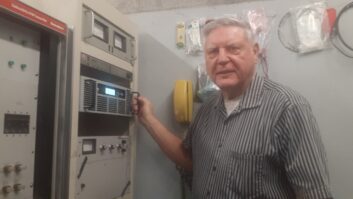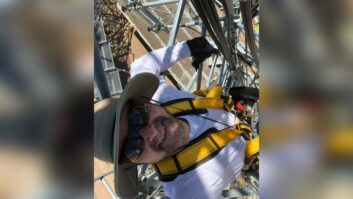
The author is a consulting engineer and station owner.
I’ve been in the broadcast engineering field since 1963, since the days of microphonic 6J7s in audio consoles thumping on the air to the announcers tapping the beat with his fingers, and changing coupling capacitors in ITC cart cue decoders three or four times in the same machines — you know, too long.
Well, in 1985, thanks to the Docket 8090 ruling, I happened to find an FM frequency that fell smack at my home in the woods on a mountaintop, in a community with no radio stations.
I had the frequency dropped in and applied, along with half of the East Coast. After four long years, I was awarded a CP, and my wife and I put on our very own station.
[Read More Guest Commentaries Here]
In spite of my limited knowledge of actually operating a station with programming, money, sponsors, money, insurance, money and just plain money, the station was quite successful even though we were the new guys in a market of 40 stations.
It was a lot of fun until deregulation, when the money guys bought up all of the stations they could and went for the throat of the successful stations, of which we were one.
A mom-and-pop operation is hard-pressed to go head to head with guys who give away $1,000 a day to listeners and have a sales staff of 20 cutthroat sales people, while we had three who were “nice guys.”
So my wife and I opted out and sold the station for a lowball figure just to be able to pay off the bank and get away from it.
I remember sitting in a burger joint after the closing saying to my wife, “I will never ever own another radio station again.” So I kept on with contract engineering a bunch of other stations; and all was well.
Can’t Say No
Over the years, we relocated a few times, and I wound up in northern Iowa doing engineering for a smaller group, taking care of 23 stations.
Although it was a decent job with decent pay, I was pushing 70, and years of traveling a thousand mile a week got to me. So I partially retired, keeping only the stations within an hour or two ride from home.
Then it happened. A broker had a small AM station in a small town for sale. Wow, it was a standalone AM. I love AM for the engineering opportunities and as an avid ham. It was a directional AM, even more fun.
The whole thing without a studio was on 15 acres of farmland, great. And most of all, the price was slightly more than a Ford F-150.
Wow, how could I go wrong? “If it flops, I can sell the farmland, cut the towers down and sell off the scrap iron and the equipment, and get my money back. Not only that, but it has an FM translator! Best of all worlds. This will be fun.”
At least that’s what I told my wife, who pointed out, “You said you would never own another radio station.” Well, I couldn’t pass it up.
Now, after operating for a few months, let me say that I wish the FM translator never existed. Single-handedly it has been the thorn to our total success.
Perception Is Reality
Why, you may ask?
Here we are in the middle of South Dakota, where the earth is solid sodium. The dry ground is white, the drinking water has got 530 mg per liter of sodium in it, but the ground conductivity is 30, best in the entire U.S. of A.
So this little 500-watter can be heard easily on the worst car radio 100 miles in just about every direction. The 2 mV/m contour in the lobe goes into North Dakota, about 90 miles away.
Okay, so much for this little screamer, now the FM. It’s a 250-watter at the same location as the AM. No mountains in eastern South Dakota, so it’s sitting on the prairie.
Most automobile radios can hear it 15 miles — then it’s gone.
Big deal, you say, what did you expect?
Well, most of the business people in the small town want to attract business from the other small towns around. Everyone in this town already buys from them.
So the business owner drives out of town with his car radio on FM and loses the signal before he gets out of sight of the town water tower.
To which he says, “I won’t advertise on your station, I can’t even hear it at my house 15 miles away, your coverage map lies.”
He neglects to check AM and discover that at 20 miles the whip on his car is glowing cherry red from the AM RF. So we don’t get a buy.
In other words, I would rather take my chances with 25% of the people who listen to the FM going to the AM and carrying it for 100 miles than giving the FM listeners the idea we peter out at 15 miles and never try AM.
I know it’s a different story in places like Pennsylvania, New York, Wisconsin and the like, where you can put the FM on a mountaintop and the ground conductivity is 1, so you can have a 250-watt FM that blows a 5 kW AM out of the water. But it ain’t so here.
I think my AM revitalization will involve pulling the plug on the FM and not offering the choice.
I see a lot of small-town AMs that succeed. From the service we give the town we will, but it won’t be from the business people in our city of license, it will be the people 50 miles out who never knew about the FM.
Radio World invites industry-oriented commentaries and responses. Send to Radio World.







